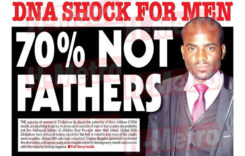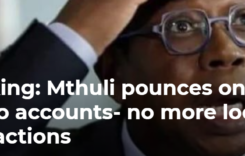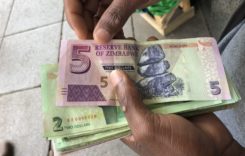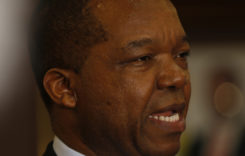By Geoffrey Nyarota
The darkest episode of my 42-year long career as a professional journalist, as well as a moment of shame for our then newspaper, the original Daily News, was on Tuesday, 23 April 2002.
The following morning, on Wednesday 24 April, was the occasion of my greatest pride as a newspaper editor. We resorted that day to a time honoured ethical practice in journalism; that of publishing a retraction of an article deemed to have been false, while tendering appropriate apologies to all concerned.
Newspaper readers of that period will remember the infamous Tadyanemhandu catastrophe at a time when the newspaper was riding high on a wave of popularity. The sensational story that graced our front page on the Tuesday appeared under the headline: “Young girls see the head of their mother cut off.”
At that time, this was a sensational headline in the context of the political violence then ravaging the north-eastern regions of Zimbabwe. On the morning of publication, we received a barrage of calls from all over, all of them protesting that we had published a false story. How they knew so early in the morning that a story from rural Magunje, 200 km away, was a falsehood was a mystery.
Efforts to trace the only source of the story, the husband of the deceased woman, were in vain. He had walked into the newsroom in tears while narrating his woeful tale about the murder of his wife. Because of the outcry and our decision not to send a reporter to the violence ridden territory to investigate, we took a decision to retract the story.
Ethics of journalism
We abided by one of the most cardinal of the ethics of journalism. If published information turns out to be false it must be retracted as promptly as possible, with the retraction being accompanied by a sincere apology. The retraction must be displayed as prominently as possible on the same page on which the offending story was published.
While The Daily News rushed, with commendable speed, to retract what was deemed to be a false story, today, sadly, some news outlets are reluctant or refuse outright to publish any retraction. This happens even when it is clear that they have published a damaging falsehood about an innocent individual. I speak from the experience of being a victim of damaging fake news on six occasions, with the falsehoods being motivated by nothing other than malice.
A weekly Harare newspaper, distinguished for its patriotism, accused me at the time of the US invasion of Iraq in 2003 of urging the George Bush administration to attack Zimbabwe as well, after dealing with Saddam Hussein. I was supposed to have expressed such weird exhortation as Editor of the Daily News. At the time of the invasion of Iraq I had left the newspaper four months previously and was no longer in any way associated with the newspaper, having been dismissed in painful circumstances. My salvation was that not too many readers took the newspaper seriously.
Not to be out-done, a UK-based Zimbabwean website accused me not long afterwards of having incited Five Brigade to unleash the Gukurahundi massacres on the innocent people of Matabeleland in the early 1980s soon after independence.
In similar vein, a respectable financial newspaper in Harare published an article by a correspondent in which he expressed the view that I was the mastermind of the same Gukurahundi. Apart from that, so the highly respected journalist stated, the Willowgate Scandal was nothing but the enterprise of a young journalist on The Chronicle that I stole and presented as my own enterprise.
To his credit, the editor of the newspaper, who is one of our finest journalists in Zimbabwe, quickly retracted the malicious diatribe.
In between these two damaging fake stories, another UK-based website published a shocking article in which it was expressed as fact that I had been dismissed from The Daily News at the time of my return to Zimbabwe in 2010 because I had helped myself to a substantial amount of donor funds. The donor organisation published a statement to deny this allegation.
Shamed by the statement, the website then published a retraction accompanied by what appeared to be a sincere apology. The problem with digital footprints on social media is that they cannot be effectively erased once published and the reputations of victims of fake stories are permanently damaged.
Finally, in 2019 a well-respected Sunday newspaper published an article in which it was stated that I had been the subject of an investigation by the Zimbabwe Anti-Corruption Commission for alleged corruption. I should, therefore, not be considered for appointment to the same ZACC as a commissioner. Several prominent people had nominated me for appointment. The commission hastily issued a statement denying it had ever investigated me for any reason.
For some incomprehensible reason, the respectable newspaper in question still refused to retract the story. The matter remains before the courts since then, at great cost to me in legal fees.
If these fake stories were true I would either be in jail today, be stoned by any of the people who lost their loved ones during Gukurahundi or my reputation as an investigative journalist would be effectively shredded.
Click bait
By the time when former President Robert Gabriel Mugabe of Zimbabwe died in Singapore in September 2019, rumours of ill health had dogged him for some time. His death had been reported repeatedly in fake news accounts on Twitter or other social media over the previous three years. At one point he pointed out with sarcasm that if social media were to be taken seriously then he had died and resurrected several times.
The purveyors of these falsehoods never at any given time published any correction or retraction of their false pronouncements. The multiple alleged deaths of Mugabe no doubt attracted thousands of hits to their respective websites.
One website had the temerity to publish the following: “Rumours have been spreading on twitter and other social media outlets suggesting that President Mugabe has passed away. This is very unlikely. Mugabe is alive. Death hoaxes have been following him for the past three years and we will break the story here if anything happens.”
Fake news is described as false or misleading information which is presented to the public as truthful or genuine news. The aim of fake news is often that of damaging the reputation of the targeted person or entity, or that of making money through advertising revenue. A good portion of advertising revenue has emigrated in recent years from print media publications to the internet and fake news has become a good bait for the hits that attract advertising.
The term fake media has been applied more broadly to include any type of false information, including that which is unintentional or unconscious, especially as applying to any news unfavourable to the personal interests of high-profile individuals, especially politicians, celebrities or business people. In the United States the term was popularised by former President Donald Trump, who engaged with any media outlets that criticised him. He dismissed their content as fake news, even when it was true.
In the politically polarised atmosphere of Zimbabwe, politicians – especially the leaders of both the ruling and opposition political parties – have become the popular targets of fake news, particularly during or as elections approach.
President Emmerson Mnangagwa, as well as MDCA president, Nelson Chamisa, and his MDC-T nemesis, Douglas Mwonzora are generally regarded as fair game. Fake news is often created and disseminated by hostile political rivals.
A major problem with fake news is that detailed accounts are written without any comment being sought from the subjects, which is highly unethical. News is often anonymously hosted by fake or unidentifiable news websites. It is, therefore, difficult, if not impossible to identify and prosecute the sources of fake news for libel.
Salacious details about wealthy entrepreneurs as well as celebrities, such as musicians, soccer players or our many self-appointed prophets are guaranteed to attract the greatest number of hits. They, in turn, have learnt to accept their fate while the minutest of details about their private lives are relentlessly paraded on social media as fake news for public consumption. Strangely, some of the celebrities seem to love the fake publicity.
Fake news would never be published if journalists abided by the most rigid of the ethical standards of their profession – publication of the truth.
Another tenet of ethical journalism is that of fairness. Publishing damaging falsehoods about innocent people cannot in any way be regarded as fairness.
While false news was once common in Zimbabwe’s print media, fake news has become more prevalent with the rise of online media outlets and the concomitant emergence of citizen journalists, many of them with no formal training in journalism.
It is difficult to monitor some of today’s citizen journalists, Anyone with a mobile phone can become an instant photographer, and stories, even of horrific accident scenes are crafted around the pictures without reference to any official source.
The greatest victim of fake news is professional journalism.
Do you want to use our content? Click Here












